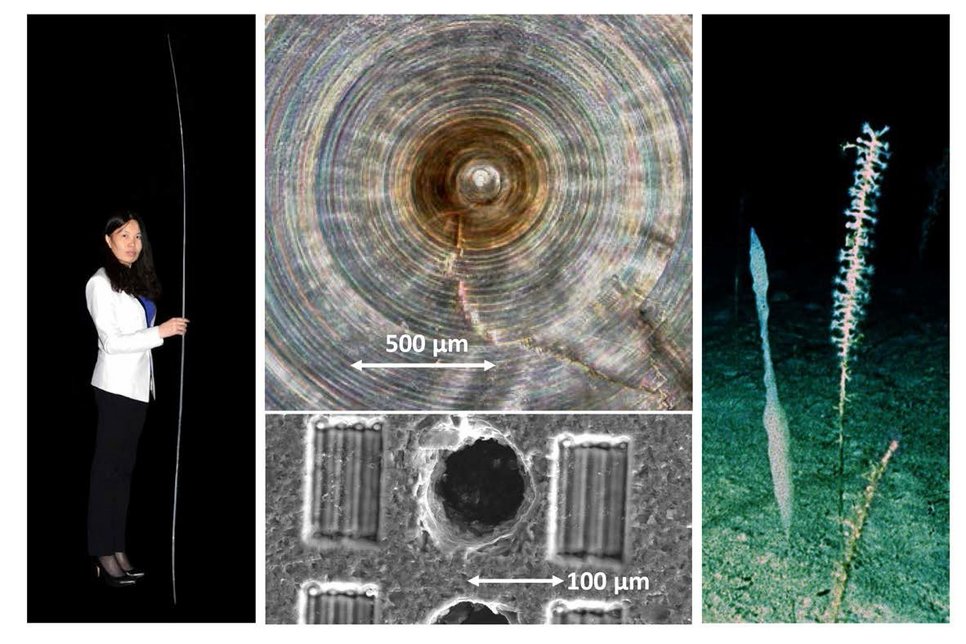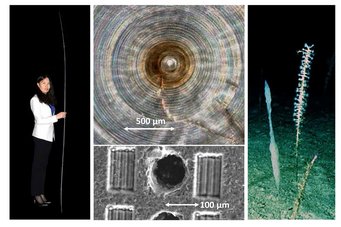Silicon Content of the Oceans 15,000 Years Ago Higher than Today
Jahrtausende alte Glasschwämme erweisen sich wieder mal als aufschlussreiches Klimaarchiv
The first glass sponges lived in Earth's oceans more than 600 million years ago. They can live to be many thousands of years old and are thus among the oldest multicellular animals. A recent study led by the Max Planck Institute for Chemistry in Mainz, based on silicon isotope measurements on glass sponge cross-sections and germanium-to-silicon content analyses in seawater samples, found that, 14,000 to 18,000 years ago, the concentration of dissolved silicon in the deep Pacific was twelve percent higher than today. Researchers assume that this influenced atmospheric CO2 levels during deglaciation. The study was published in late 2017 in the scientific journal Geophysical Research Letters.

The presence of silicon in ocean water is an important prerequisite for the existence of diatoms. They live on the surface of the oceans and build their shells from dissolved silica. These diatoms form a component of the carbon cycle, which is important for life on Earth. The carbon cycle encompasses the entirety of all processes that convert carbon and its chemical compounds on Earth. During photosynthesis, the diatoms absorb carbon from the atmosphere and convert it into organic carbon. When the diatoms die, they sink to lower levels in the oceans and are responsible for about half of the total carbon sinking into the deep ocean. This makes the diatoms an important element in regulating the CO2 concentration of the atmosphere.
Glass sponge 'growth rings'
By examining five cross-sections of Monorhaphis chuni spicules that were only a few millimeters thick and aged between 5,000 and 18,000 years, the team, headed by Klaus Peter Jochum from the Department of Climate Geochemistry at the MPI for Chemistry in Mainz, determined that the concentration of dissolved silica in the deep Pacific 14,000 to 18,000 years ago was approximately twelve percent higher than it is today. Similar to growth rings in trees, which contain information on forest fires or dry phases, the spicule cross-sections reveal the concentration of nutrients over time. This makes them an excellent archive for tracking past climate change.
'Very few of these very old glass sponge samples are available,' explains Group Leader Klaus Peter Jochum, who arrived at the fascinating research subject thanks to the sponge experts and biologists Werner E. G. Müller and Xiaohong Wang of the Institute of Physiological Chemistry at the University Medical Center in Mainz. While the silicon isotopes in the cross-sections were measured at Potsdam's GeoForschungsZentrum (GFZ), the MPIC laboratory in Mainz examined the germanium concentration and compared the data with current deep-sea water samples.
Silicon and its 'geochemical twin' germanium behave very similarly in seawater and today display a constant ratio of germanium to silicon (Ge/Si) of 0.7 μmol/mol. Because the Ge/Si results from the outer edges of the glass sponge samples displayed excellent correlation with the ratio in seawater today, the Mainz scientists were sure that even the innermost glass spicule rings represented a good model archive of their seawater environment several thousand years ago.
'The new data help to fill an important gap in the palaeonutrient record. To date, very little data on the silicon and germanium content in the deep sea 18,000 years ago has been available to science,' said Gerald Haug, Director of the Department of Climate Geochemistry. For co-author Flip Froelich of Duke University in Durham, USA, there are two possible reasons for the greatly increased silicon concentration at the end of the last ice age: 'Mainland sources such as wind or rivers may have added more silica to the ocean during the deglaciation. Or, less carbon bound in dead diatoms sank into the deep sea, which is suggested by glacial-era reconstructions of the Antarctic Ocean biological pump around the Antarctic.' (AR)
